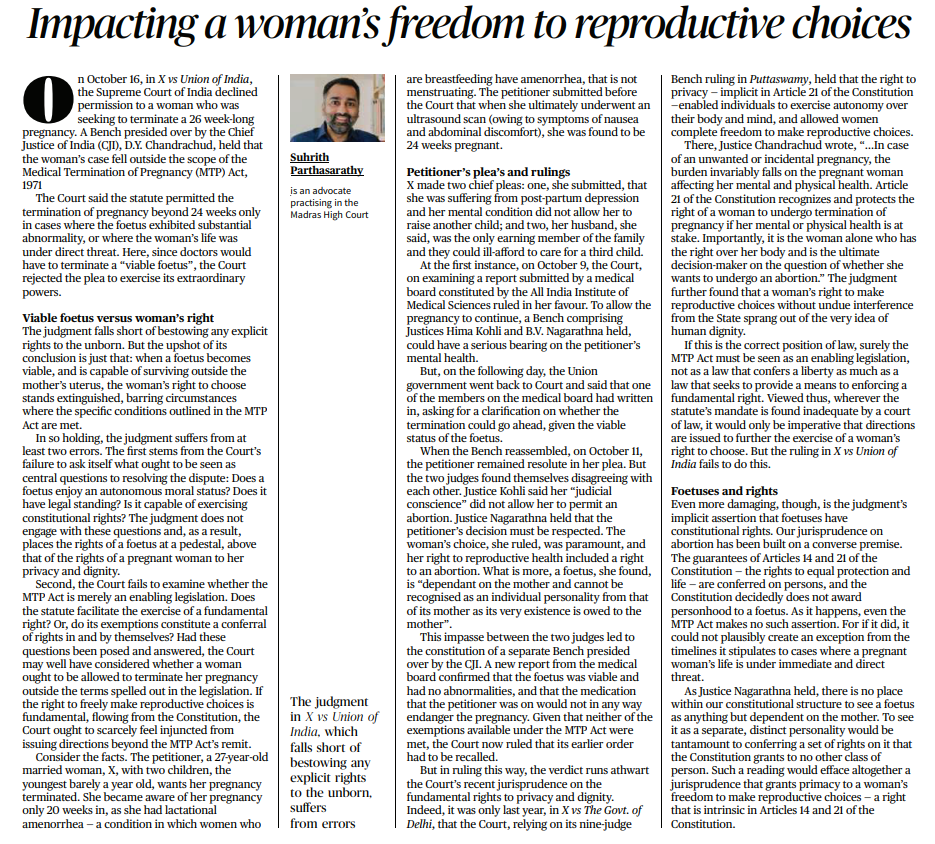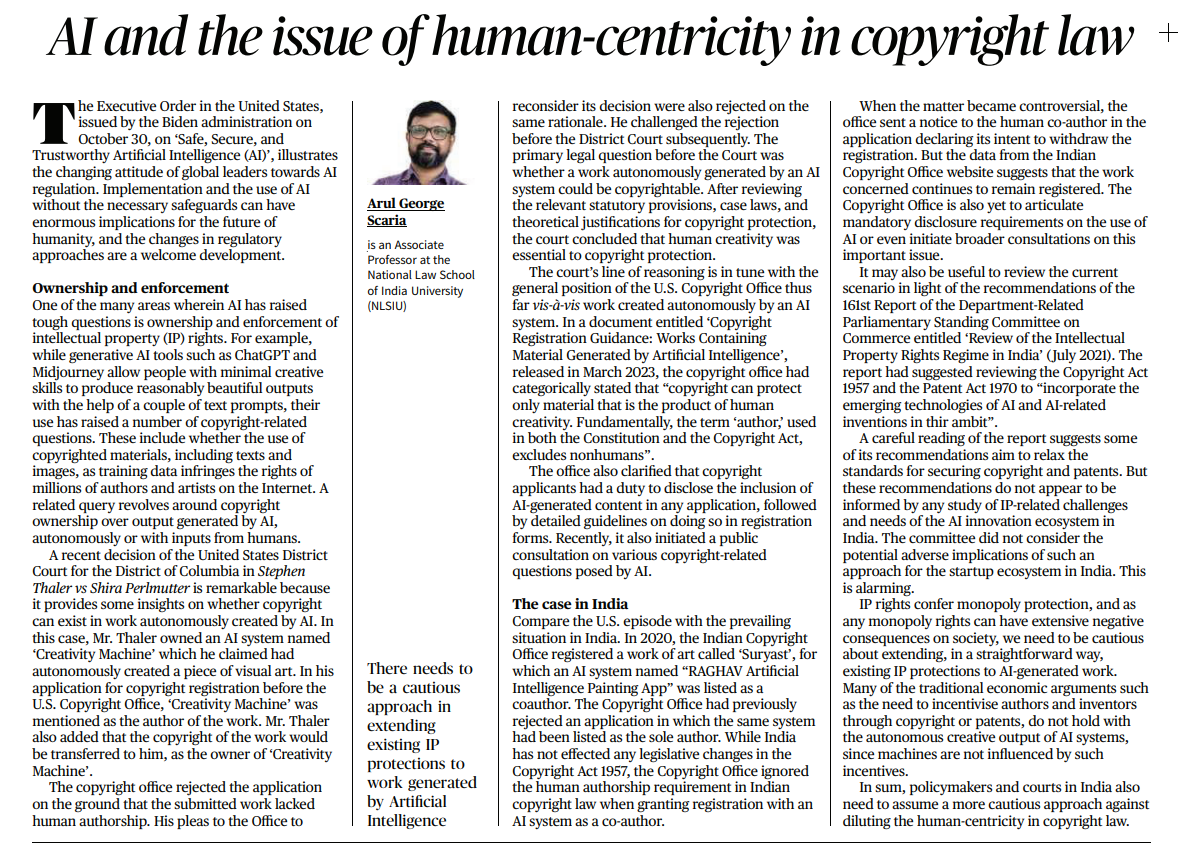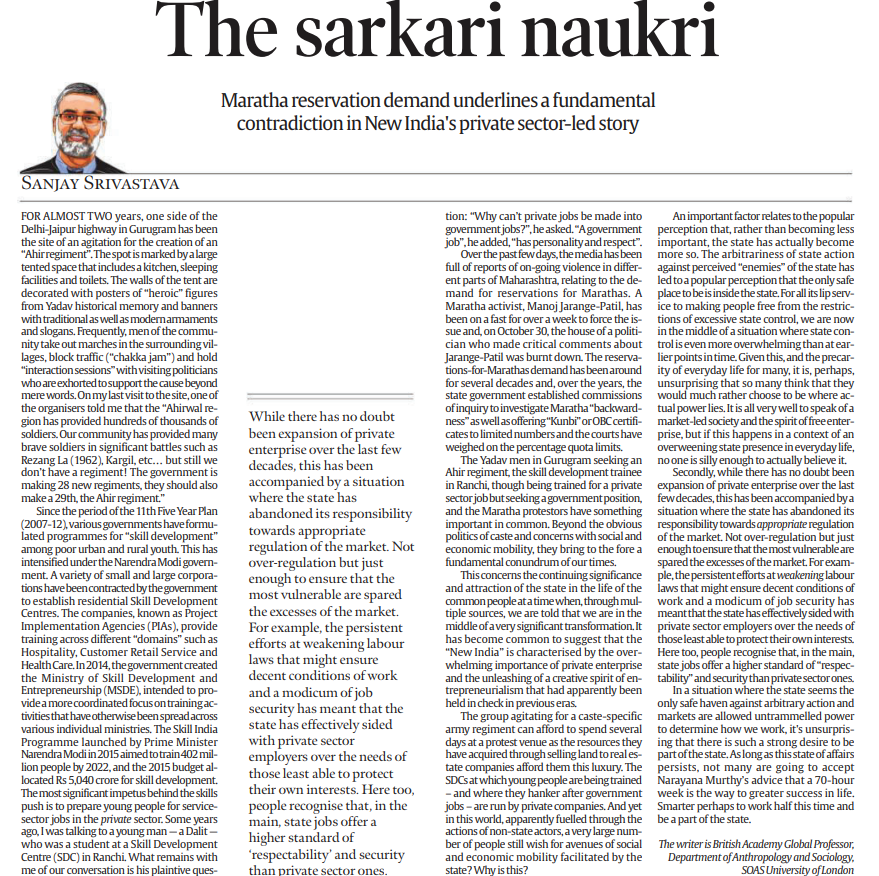Introduction:
On October 16, in the case of X vs Union of India, the Supreme Court of India declined permission to a woman who sought to terminate a 26-week-long pregnancy.
The Court’s decision, presided over by Chief Justice D.Y. Chandrachud, was based on the Medical Termination of Pregnancy (MTP) Act, 1971, which permits pregnancy termination beyond 24 weeks only in cases of substantial foetal abnormality or direct threat to the woman’s life.
Viable Foetus vs Woman’s Right:
The judgment highlighted the critical distinction between a viable foetus and a woman’s right to choose.
When a foetus becomes viable, capable of surviving outside the mother’s uterus, the woman’s right to choose is extinguished, except in specific conditions outlined in the MTP Act.
The judgment, however, raises concerns in two areas.
- Absence of Clarification on Foetal Rights:
- The judgment fails to address fundamental questions related to the foetus’s autonomous moral status, legal standing, and constitutional rights.
- This omission places the rights of a foetus above the rights of a pregnant woman, impacting her privacy and dignity.
- Lack of Clarity on the MTP Act:
- The Court does not examine whether the MTP Act is an enabling legislation or if its exemptions constitute a conferral of rights.
- This oversight prevents the Court from considering whether a woman should be allowed to terminate her pregnancy outside the terms spelled out in the legislation.
- If reproductive choice is a fundamental right, the Court should have the authority to issue directions beyond the MTP Act’s scope.
Petitioner’s Plea and Rulings:
- The petitioner, a 27-year-old woman with two children and experiencing post-partum depression, sought to terminate her pregnancy due to her mental health and financial constraints.
- Initially, the Court ruled in her favor based on a medical board’s report but later reversed its decision due to concerns about the foetus’s viability.
Inconsistencies with Recent Jurisprudence:
- The judgment contradicts the Court’s recent jurisprudence on fundamental rights to privacy and dignity.
- In a previous case (X vs The Govt. of Delhi), the Court recognized the right to privacy as enabling individuals to exercise autonomy over their body and mind, including the freedom to make reproductive choices.
- This ruling emphasized that a woman’s right to make reproductive choices without undue interference from the State is essential for human dignity.
Foetuses and Constitutional Rights:
- The judgment implicitly suggests that foetuses have constitutional rights, contrary to the established legal premise.
- The Constitution does not grant personhood to a foetus, as it is considered dependent on the mother.
- Viewing the foetus as a separate personality would be inconsistent with constitutional principles and existing jurisprudence that prioritizes a woman’s freedom to make reproductive choices.
Conclusion:
The X vs Union of India judgment raises critical questions regarding the balance between a woman’s reproductive rights and the status of a foetus. It fails to clarify the legal and constitutional positions of foetuses and the scope of the MTP Act.
The decision seems to depart from recent jurisprudence emphasizing a woman’s right to autonomy over her body and reproductive choices, potentially setting a concerning precedent for future cases.
Introduction
The Executive Order issued by the Biden administration on October 30, titled ‘Safe, Secure, and Trustworthy Artificial Intelligence (AI),’ reflects the shifting attitudes of global leaders towards AI regulation.
It emphasizes the need for safeguards in AI implementation to mitigate the potential consequences for humanity. This shift in regulatory approaches is considered a positive development.
Ownership and Enforcement:
- Copyright Concerns: The use of AI, particularly generative AI tools like ChatGPT and Midjourney, has raised questions about intellectual property (IP) rights, including copyright.
There are concerns about the use of copyrighted materials in training data and the ownership of output generated by AI, whether autonomously or with human inputs.
- US District Court Case: The United States District Court for the District of Columbia, in the case of Stephen Thaler vs. Shira Perlmutter, deliberated on whether autonomously generated AI works could be eligible for copyright protection.
The court ruled that human creativity was essential for copyright protection, aligning with the US Copyright Office’s stance.
- US Copyright Office’s Position: The US Copyright Office, in a document released in March 2023, asserted that copyright can protect only material produced by human creativity and that the term ‘author’ excludes nonhumans.
They mandated disclosure of AI-generated content in copyright applications and initiated a public consultation on AI-related copyright issues.
The Case in India:
- Indian Copyright Office: In contrast to the US, the Indian Copyright Office registered a work of art with an AI system as a co-author, bypassing the human authorship requirement. This caused controversy, but the Copyright Office did not clarify disclosure requirements or initiate comprehensive consultations on AI’s role in copyright.
- Parliamentary Standing Committee Report: The 161st Report of the Department-Related Parliamentary Standing Committee on Commerce suggested reviewing Indian IP laws to incorporate emerging technologies like AI.
Some recommendations aimed to relax standards for securing copyright and patents but lacked a thorough understanding of AI-related IP challenges and their impact on the startup ecosystem.
- Caution in Extending IP Protections: IP rights confer monopoly protection, which can have negative consequences on society.
While traditional economic arguments for copyright and patents do not apply to AI-generated work, there is a need for caution when extending existing IP protections to AI-created content.
- Human-Centricity in Copyright Law: Policymakers and courts in India are advised to maintain human-centricity in copyright law and consider the unique challenges posed by AI-generated works.
Conclusion
The Executive Order on AI regulation in the US reflects a changing global attitude towards AI, with a focus on safeguards. The cases in the US and India highlight the contrasting approaches to AI-generated content in copyright law, emphasizing the need for a balanced and cautious approach to protect both human creativity and innovation in the AI ecosystem.
Introduction
The editorial analysis discusses three distinct instances in India that highlight the enduring importance of the state in the lives of common people.
These cases involve demands for a caste-specific army regiment, the quest for government jobs by skill development trainees, and ongoing protests for reservations among the Maratha community.
Despite the prevailing narrative of the rise of private enterprise and entrepreneurialism in “New India,” the state remains a crucial element in people’s pursuit of social and economic mobility.
The Ahir Regiment Protest
- For nearly two years, a section of the Delhi-Jaipur highway in Gurugram has been occupied by Yadav men advocating for the creation of an “Ahir regiment.”
- The protestors emphasize their community’s significant contributions to the Indian military, and they assert their right to a dedicated regiment.
- This protest is a testament to the continued relevance of the state as it highlights the demand for state recognition and support, even in an era of economic liberalization.
Skill Development and Government Jobs
- The government’s emphasis on skill development programs, especially under the leadership of Prime Minister Narendra Modi, underscores a push to prepare young people for private sector jobs.
- However, as observed in a conversation with a Dalit skill development trainee in Ranchi, there is a prevailing desire for government jobs.
- The allure of a government job lies in its perceived prestige, security, and status, illustrating that the state still holds a significant position in the aspirations of the Indian youth.
Maratha Reservation Protests
- Ongoing violence in Maharashtra related to the demand for reservations among the Maratha community exemplifies the persisting importance of state intervention in affirmative action and social justice.
- Despite the state’s commissions of inquiry and legal battles on quota limits, the struggle for reservations continues, underlining the role of the state as a crucial actor in addressing social inequalities.
The Role of the State
- This argues that the state remains relevant and attractive to many, even in a time when the private sector is purportedly gaining prominence.
- Two primary factors contribute to this phenomenon. Firstly, the arbitrary exercise of state power against perceived adversaries has led to a perception that being within the state is the safest position.
- Despite the rhetoric of a market-led society, state control is arguably more overwhelming than before, reinforcing the appeal of state institutions.
The Abandonment of State Regulation
- The second factor is the decline of state regulation in favor of private enterprise.
- Weakening labor laws and limited market oversight have favored employers over vulnerable workers.
- This has created a scenario where state jobs offer more security and respectability than private sector employment, further underscoring the importance of the state in individuals’ aspirations.
Conclusion
In contemporary India, the state’s significance endures due to its perceived role as a safe haven against arbitrary actions and its ability to provide a sense of security and regulation in an environment where the private sector dominates.
As long as this dynamic persists, many will continue to seek opportunities within the state, prioritizing stability and dignity over market-driven success.




